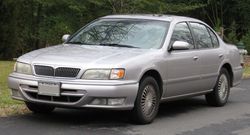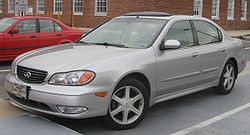- Infiniti I
-
≠
Infiniti I30 
Manufacturer Infiniti Also called Nissan Cefiro
Nissan Maxima
Nissan QXProduction 1996–2004
2000-2009(Middle East Market)Assembly Oppama, Japan Predecessor Infiniti J30 Successor Infiniti M (for the M35)[1] Class Mid-size luxury car Body style 4-door sedan Layout FF layout The Infiniti I30 and I35 are mid-size luxury cars sold under Nissan's Infiniti marque in North American markets. The I was a rebadged Nissan Cefiro or Nissan GT-R (日産 セフィーロ) and was mechanically related to the Nissan Maxima and also to the GTR family edition . In the GCC region it was rebadged as Nissan Maxima. There is also an 'i30 turbo (touring).
Contents
First generation (A32)
First generation 
Also called Nissan Maxima Production 1996–1999 Engine 3.0L 190 hp (142 kW) V6 Transmission 4-speed automatic
5-speed manualWheelbase 2700 mm (106.3 in.) Length 4815 mm (189.6 in.) Width 1770 mm (69.7 in.) Height 1415 mm (55.7 in.) Curb weight 3,090 lb (1,402 kg) - 3,194 lb (1,449 kg) The 1996 I30 used a 3.0L VQ30DE V6 engine shared with the Maxima, as it was Infiniti's first rebadged North American Nissan. It produced 190 hp (142 kW). The "near-luxury" I30 was Infiniti's top seller. All I30/I35s were built in Oppama, Japan (the former home of the Maxima). The very first I30 was built on June 27, 1995. The I30 was Infiniti's entry-level car for 1997–1998, and the return of the Infiniti G20 in 1999 returned to take over from the I30 as Infiniti's entry-level car.
Infiniti released the original I30 in 1996 as a replacement for their aging J30 sedan, which was a rear-wheel drive car. Although the overseas Nissan Primera based G20 was technically Infiniti's least expensive model, the I30 was the company's mid-level luxury car, whereas the entry level G20 competed against the likes of Acura Integra, BMW 3 Series, and Mercedes C-class. I30 was aimed at buyers who would otherwise be considering the Mercedes-Benz E-Class, BMW 5 Series and Saab 9-5.
Infiniti made several revisions to the I30 throughout the mid and late 1990s, including a fairly tail lights and the touring model now had 5 spoke wheels instead of the old BBS wheels. The Touring model included more aggressive suspension tuning as well as a spoiler and BBS wheels, and a small percentage of first-generation I30s had 5-speed manual transmissions, many with VLSD. An In-Dash hands-free car phone was also available as an option.
Second generation (A33)
Second generation 
Also called Infinti I35 (2002–2004)
Nissan MaximaProduction 2000–2004
2000-2009 (Middle East)Engine 3.0L VQ30DE V6, 227 hp (2000—2001)
(2000—2009) (Middle East)
3.5L VQ35DE V6, 255 hp (2002—2004)Transmission 4-speed automatic
5-speed manual (Middle East only)Wheelbase 2750 mm (108.3 in.) Length 4920 mm (193.7 in.) Width 1785 mm (70.2 in.) Height I35: 1450 mm (57.0 in.)
I30 Luxury: 1438 mm (56.5 in.)
I30 Touring: 1443 mm (56.7 in.)Curb weight 3,042 lb (1,380 kg) (I30 Manual Middle East)
3,109 lb (1,410 kg) (I30 Automatic Middle East)
3,342 lb (1,516 kg) (I30 Base)
3,415 lb (1,549 kg) (I30 Touring)
3,306 lb (1,500 kg) (I35)The I30 was redesigned for 2000 along with the Nissan Maxima. Engine power was up to 227 hp (169 kW) but the manual transmission was no longer offered (except in Middle East).
In late 2001 the model got its most significant host of upgrades, including minor revisions to the interior, new optional equipment, larger brakes, a re-tuned suspension system, and standard stability control. The car was renamed I35 to reflect an engine-displacement increase from 3.0 to 3.5 L. Nissan's VQ35DE V6 produced 255 hp (190 kW). Styling was also updated.
Infiniti wanted to convince buyers that the new suspension tuning, enlarged brakes, stability control and 255 horsepower engine had transformed the I into more of a sports sedan and less of sedate entry-level model, but was largely unsuccessful. The model was only available with a 4-speed automatic transmission and front wheel drive, meaning that the ES300 and Acura's pre-existing second generation 3.2TL remained its closest competitors, with models like the BMW 5-Series remaining out of its league.
In September 2004, Nissan announced that I35 production would cease and that model year 2004 would be the last for this vehicle. It was also the last remaining front-wheel drive Infiniti since the Infiniti G20 ended production after the 2002 model year. Infiniti discontinued the I after a short run of 2004 models. The I was succeeded by the new Infiniti M (introduced for 2003).[1]
In Indonesia, the early models were sold from the year 2000 to 2002 as Infiniti I30 Standard and Touring. The late models from 2002 to 2003 was sold as Nissan Cefiro 3.0 Brougham VIP.
This version continued to be sold in the Middle East as the Nissan Maxima with both automatic and manual transmissions until 2009.[2]
References
- ^ a b "Blog – The automotive blog for Canadians. Car reviews, auto news, road tests…". Carpages.ca. http://www.carpages.ca/go/roadtest/2006_infiniti_m_preview.aspx. Retrieved 2011-11-05.
- ^ "Nissan Maxima (2000 - 2009) - Prices & Specs - Drive Arabia >> UAE (Dubai / Abu Dhabi), Saudi, Oman, Qatar, Bahrain, Kuwait & GCC". Drive Arabia. http://www.drivearabia.com/ultimatecarbuyerguide/carpage.php/Nissan-Maxima/2000-2001-2002-2003-2004-2005-2006-2007-2008-/97. Retrieved 2010-10-11.
Infiniti, a division of Nissan Motor Co., Ltd., road car timeline, 1990–present Type 1990s 2000s 2010s 0 1 2 3 4 5 6 7 8 9 0 1 2 3 4 5 6 7 8 9 0 1 Coupe M30 G35C G37C Entry-level G20 G20 G35 G25/G35/G37 Mid-size I30 I30 / I35 J30 M45 M35 / M45 M37 / M56 Full-size Q45 Q45 Q45 SUV EX35 / EX37 FX35 / FX45 FX35 / FX50 QX4 QX56 QX56 External links
- Official Infiniti USA site
- Wikianswers - Infiniti I30 FAQ
Categories:- Infiniti vehicles
- Front wheel drive vehicles
- Mid-size cars
- Sedans
- 1990s automobiles
- 2000s automobiles
- Vehicles introduced in 1996
Wikimedia Foundation. 2010.
